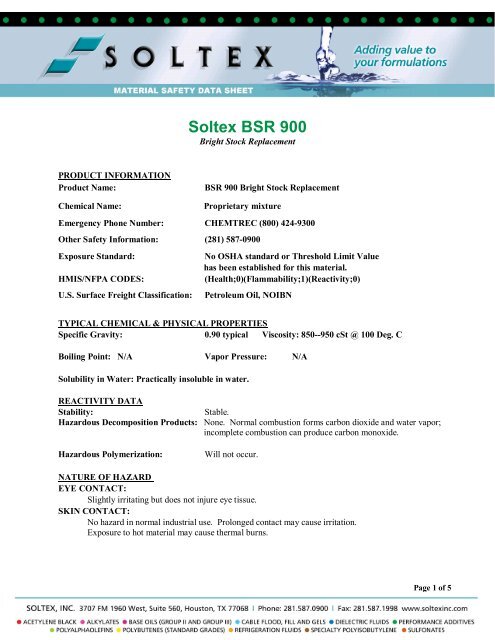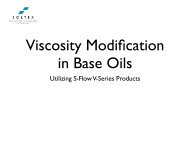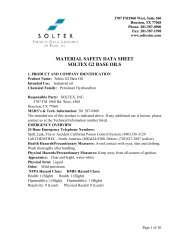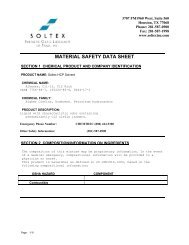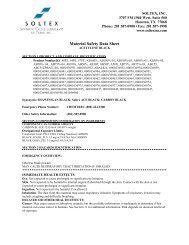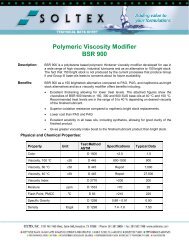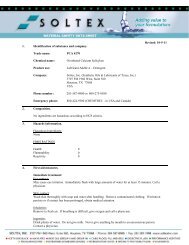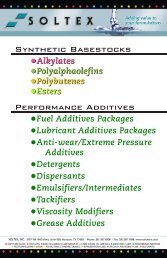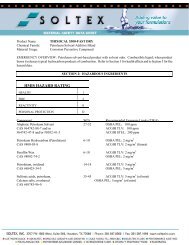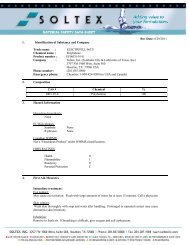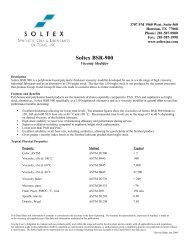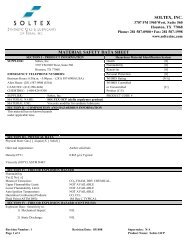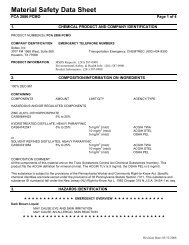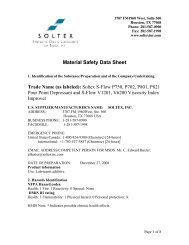Soltex BSR 900
Soltex BSR 900
Soltex BSR 900
You also want an ePaper? Increase the reach of your titles
YUMPU automatically turns print PDFs into web optimized ePapers that Google loves.
<strong>Soltex</strong> <strong>BSR</strong> <strong>900</strong><br />
Bright Stock Replacement<br />
PRODUCT INFORMATION<br />
Product Name:<br />
<strong>BSR</strong> <strong>900</strong> Bright Stock Replacement<br />
Chemical Name:<br />
Proprietary mixture<br />
Emergency Phone Number: CHEMTREC (800) 424-9300<br />
Other Safety Information: (281) 587-0<strong>900</strong><br />
Exposure Standard:<br />
No OSHA standard or Threshold Limit Value<br />
has been established for this material.<br />
HMIS/NFPA CODES:<br />
(Health;0)(Flammability;1)(Reactivity;0)<br />
U.S. Surface Freight Classification: Petroleum Oil, NOIBN<br />
TYPICAL CHEMICAL & PHYSICAL PROPERTIES<br />
Specific Gravity: 0.90 typical Viscosity: 850--950 cSt @ 100 Deg. C<br />
Boiling Point: N/A Vapor Pressure: N/A<br />
Solubility in Water: Practically insoluble in water.<br />
REACTIVITY DATA<br />
Stability:<br />
Stable.<br />
Hazardous Decomposition Products: None. Normal combustion forms carbon dioxide and water vapor;<br />
incomplete combustion can produce carbon monoxide.<br />
Hazardous Polymerization:<br />
Will not occur.<br />
NATURE OF HAZARD<br />
EYE CONTACT:<br />
Slightly irritating but does not injure eye tissue.<br />
SKIN CONTACT:<br />
No hazard in normal industrial use. Prolonged contact may cause irritation.<br />
Exposure to hot material may cause thermal burns.<br />
Page 1 of 5
HEALTH INFORMATION & PROTECTION<br />
INHALATION:<br />
Negligible hazard at ambient (-18 to 38 Deg. C; 0 to 100 Deg. F) or recommended blending<br />
temperature.<br />
Avoid breathing vapors or mists.<br />
INGESTION:<br />
Minimal toxicity. Give water. Do not induce vomiting.<br />
FIRST AID<br />
EYE CONTACT:<br />
Flush eyes with large amounts of water until irritation subsides. If irritation persists, get medical<br />
attention.<br />
INHALATION:<br />
Use proper respiratory protection, immediately remove the affected victim from exposure. Administer<br />
artificial respiration if breathing is stopped. Keep at rest. Call for prompt medical attention.<br />
INGESTION:<br />
First aid is normally not required.<br />
WORKPLACE EXPOSURE LIMITS<br />
THE FOLLOWING OCCUPATIONAL EXPOSURE LIMITS ARE RECOMMENDED:<br />
Due to the oil-based components of this mixture, if misting occurs, control of exposure to 5mg/m3 or<br />
less is recommended.<br />
PRECAUTIONS<br />
PERSONAL PROTECTION:<br />
For open systems where contact is likely, wear safety glasses with side shields.<br />
Where contact may occur, wear safety glasses with side shields.<br />
Where contact may occur with hot materials, wear thermal resistant gloves, arm<br />
protection and a face shield.<br />
Where concentrations in air may exceed the limits given in this section and engineering,<br />
work practice or other means of exposure reduction are not adequate, NIOSH/MSHA<br />
approved respirators may be necessary to prevent overexposure by inhalation.<br />
VENTILATION:<br />
The use of mechanical dilution ventilation is recommended whenever this product is used in confined<br />
space, is heated above ambient temperatures, or is agitated.<br />
Page 2 of 5
FIRE AND EXPLOSION DATA<br />
Flash Point:<br />
Flammable Limits:<br />
Extinguishing Media:<br />
Fire Fighting:<br />
210 Deg. C min.<br />
N/A<br />
CO2, Dry Chemical, Foam, or any Class B agent.<br />
Firefighters or others exposed to vapors or products of combustion<br />
should wear full protective clothing and self-contained breathing<br />
apparatus. Thoroughly decontaminate equipment after use.<br />
STORAGE AND ENVIRONMENTAL PROTECTION<br />
STORAGE REQUIREMENTS:<br />
No special requirements<br />
SPILLS AND LEAKS:<br />
Remove mechanically or contain on an absorbent material. Treat as an oil spill.<br />
WASTE DISPOSAL:<br />
Disposal must be in accordance with applicable federal, state, or local regulations. Determine waste<br />
classification at time of disposal. Conditions of use may render the spent product a hazardous waste.<br />
Enclosed-controlled incineration is recommended unless directed otherwise by applicable ordinances.<br />
EMPTY CONTAINERS:<br />
The container for this product can present explosion or fire hazards, even when emptied. To avoid<br />
risk of injury, do not cut, puncture, or weld on or near this container. Since the emptied containers<br />
retain product residue, follow label warnings even after container is emptied.<br />
TRANSPORTATION INFORMATION<br />
U.S. DEPT OF TRANSPORTATION<br />
Shipping Name<br />
Elevated Temperature Liquid, N.O.S.<br />
Hazard Class 9<br />
Identification Number UN3257<br />
Packing Group<br />
III<br />
Page 3 of 5
INTERNATIONAL TRANSPORTATION INFORMATION:<br />
Sea (IMO/IMDG)<br />
Shipping Name Elevated Temperature Liquid, N.O.S.<br />
Class 9<br />
Packing Group III<br />
UN Number UN3257<br />
Air (ICAO/IATA)<br />
Shipping Name Not regulated for non-bulk shipments only, Bulk shipment prohibited.<br />
European Road/Rail (ADR/RID)<br />
Shipping Name Not Regulated.<br />
Canadian Transportation of Dangerous Goods<br />
Shipping Name Elevated Temperature Liquid, N.O.S.<br />
Hazard Class 9<br />
UN Number UN3257<br />
Packing Group III<br />
REGULATORY INFORMATION<br />
TSCA Status:<br />
This product is listed on the TSCA inventory.<br />
DOT Hazard Class/ID Number:<br />
Not applicable.<br />
CERCLA SECTIONS 102a/103 HAZARDOUS SUBSTANCES (40 CFR Part 302.4): This product is not<br />
reportable under 40 CFR Part 302.4.<br />
SARA TITLE III SECTION 302 EXTREMELY HAZARDOUS SUBSTANCES (40 CFR Part 355):<br />
This product is not regulated under Section 302 of SARA and 40 CFR Part 355.<br />
SARA TITLE III SECTIONS 311/312 HAZARDOUS CATEGORIZATION (40 CFR Part 370): This<br />
product is not regulated under SARA Title III Section 311/312.<br />
SARA TITLE III SECTION 313 (40 CFR Part 372): This product is not regulated under Section 313 of<br />
SARA and 40 CFR Part 372.<br />
Page 4 of 5
U.S. INVENTORY (TSCA): Listed on inventory.<br />
OSHA HAZARD COMMUNICATION STANDARD: Not hazardous per 29 CFR 1910.1200(d).<br />
WHMIS Controlled Product Classification: Not a Controlled Product under Canada's Workplace<br />
Hazardous Material Information System.<br />
EC INVENTORY (EINECS/ELINCS): In compliance.<br />
JAPAN INVENTORY (MITI): Listed on inventory.<br />
AUSTRALIA INVENTORY (AICS): Listed on inventory.<br />
KOREA INVENTORY (ECL): Listed on inventory.<br />
CANADA INVENTORY (DSL): All of the components of this product are listed on the DSL.<br />
PHILIPPINE INVENTORY (PICCS): Not determined.<br />
No warranties, express or implied, including warranties of merchantability or fitness for a particular use are made with respect to the<br />
products described herein. Nothing contained herein shall constitute permission or a recommendation or inducement to practice any<br />
invention covered by a patent without the permission of the patent owner. Customers/users are advised to test the product in advance to<br />
make certain it is suitable for their particular production conditions and use or uses of the product. Seller shall not be liable for and the<br />
customer assumes all risk and liability for any use or handling of the product. Date: 07/19/2010<br />
Page 5 of 5


